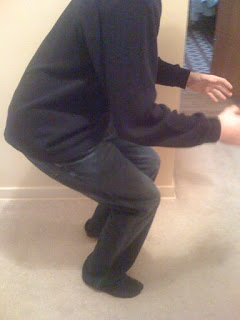What I really meant to say is: Have I told you... why is it harder to ski down steeper slopes, and why our own time-tested movements seem to do even worse on the more challenging terrain we tackle? Yes, that was the question.
Anyways, just as there is a difference in the slope itself, there is a resulting difference in the way we want to ski these slopes to maintain control while we ski, and look good doing it while skiing past the luxury catered ski chalets.
Making sure that your body remains over your base of support (a.k.a. your feet) is essential to maintaining an effective, balanced stance that will allow you to make efficient and controlled movements in your skiing.
I am going to let you in on my little trade secret - the perpendicular skier. Now I don't mean to bash your lack of geometry knowledge (I would much rather brag about mine), but the perpendicular skier is a great way to think of one's body position when skiing.
What is this "perpendicular skier?"

Basically, what you want to do is try and keep your torso perpendicular to the slope. (For those of you still struggling with the geometry concept, perpendicular means at 90 degree angles to one another).
And why do I bring up geometry at a time like this when we were trying to learn how to ski the steeps? Let me explain.
Whenever you start down the double black diamond cliff, your body position changes relative to the pitch of the slope. If you maintain the same body position on this pitch as the position you skied down the bunny slope, I can say with a percentage of accuracy that is higher than the 99.9% of germs that antibacterial hand sanitizer, that you will fall straight back on your behind. Let's look at the following figure for an example:

In this image (praise my revolutionary artistic abilities later), I took the skier in the first image and pasted his exact body and skis to the steeper slope in the second image. The key here lies in the angles between the skier's body (represented by the purple line) and the pitch of the slope (represented by the blue line).
You can see that as the pitch of the slope increases, the angle that the black arrow points to decreases markedly. You should also take note of the fact that the angle is now less than 90 degrees, meaning that the skier is now leaning backwards relative to the slope. Three guesses what happens next to this poor little skier man...
Therefore, the lesson here is, as you attack the steeps, make sure you lean more forward to maintain a perpendicular or slightly forward of perpendicular body position (See July 2009 article: "A Balance Tip That Is Slightly More Than 'Lean Forward'"). This gives you more balance and therefore control when skiing these steeps.
Now go out there and shred up those steeps, and a shout out to those of you on the US east coast - Washington D.C. received more than a foot and a half of snow last week I hear. I wonder which reader received the most...let us know via the comments. And for those metric-system-lovers out there, that is about 46 cm.


















